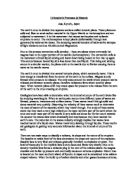There are two main ways to classify a volcano, its shape and the nature of its eruption. The basaltic or acidic level of the lava determines the shape and nature of the explosion. Basaltic lava is very fluid and releases gradually therefore no explosive eruption. The level of viscousity in the rhyolitic lava is very dense and flows very slowly. Due to its density rhyolitic lava forms a volcanic plug in the vent of the volcano above the magma chamber and builds up pressure and eventually causes an extreme explosion. Mount Aso is located on the most southern island of Kyushu in Japan and is considered to be caldera shaped volcano. When the build up of carbon dioxide and other gasses becomes extreme, huge explosions clear the magma chamber underneath the volcano and removes the summit of the cone. This then causes the sides of the crater to subside and widen the opening of the volcano by several kilometers. This then allows for a new cone to form in the center. A lagoon is usually formed between the outer and inner cone of this volcano. The color of the water is very torques due to the minerals and heat from the volcano. Mount Aso’s nature of eruption is classified as a Krakatoan. This shows that the eruption is exceptionally violent and may remove much of the original cone.
Mount Aso has a twenty-four kilometers wide caldera, which was formed during four major explosive eruptions from three hundred thousand to ninety thousand years ago. The four eruptions produced voluminous pyroclastic flows that covered most the Japanese island, Kyushu. The highest point of the volcano is 1592 meters above sea level.
The most recent eruption was on January 20th of 2004. An increase of thermal activity was experienced a few weeks prior to the eruption
A volcanic eruption such a level can have drastic consequences on the surrounding environment. The immense ash cloud dispensed from the volcano covered huge areas of land depending on winds. The people that live on the island Kyushu depend on agriculture more than the other three islands of Japan. The ash created by the volcano does not contain any supportive minerals for agriculture. When the ash fell down from the sky and covered compete areas of land and destroyed most of the farming industry in. The different impurities in the ash drained into the soil and later killed almost all growing plants or farming. Rainwater contaminated by the ash polluted nearby rivers, which additionally killed wildlife in the rivers and in lakes, or even seas further away from the volcano. The eruption as a whole had devastating effects on the ecosystem.
The effects on the nearby town of Takamori were horrific. The community living there needed to be relocated which their property was badly destroyed and covered in ash. There were very large health issues related to the eruption of mount Aso. Along with the ash clouds and fall the volcano also produced most small ash particles, which aren’t even visible to the naked eye. These particles as sank down after being thirsted up into the atmosphere. These ash particles where inhaled by people in Takamori. The particles cannot be absorbed into the blood safely or be extracted from the body with medical assistance. The ash particles would collect at the bottom of the lungs of the victims and in turn solidify consequently suffocating the people exposed. Also including the obvious dangerous of molten rock flowing down the side of the volcano and absolutely destroying everything in its path. The volcanic eruption is after a natural disaster and like all disaster the victims are left in a broken down psychological state. Some victims lost their families and everything they owned.
The eruption of Mount Aso had a huge effect on the local economy. The disaster created almost complete unemployment and ruined their main source of income, farming. Which didn’t recovery for another year and a half. Most economies surrounding the volcano and on the island of Kyushu which effected to a large extent. The volcano its self was a tourist attraction. Local businesses run within the area were either completely destroyed or put out of business. The trading economy wasn’t as badly effect as the tourism economy. The disaster was broadcasted not only on national television nut global. The area was closed down for tourists for six months consequently ruining the tourism economy for the central part of Kyushu and Mount Aso. The infrastructure of the central and eastern part of the island Kyushu was well affected by the eruption. Most damage was caused to roads, railways, electricity and water supply.
In response to the eruption of Mount Aso the local community remained focused and very determined to help one another and get everything back to normal as soon as possible. Due to the culture in Japan almost victims or bystanders fled but instead were very attentive to aid in the recovery. The communities surrounding the volcano were very close and supportive of one another. They set up emergency shelters for the victims who decided to stay until they found or uncovered their relatives and took those who wished to a camp away from the disaster area.
Japan is a more economically developed country therefore its disaster response units were very efficient helpful. Not only that but Japan experiences earthquakes and volcano eruption reasonably often compared to other countries. Emergency response and Search and Rescue units were very cooperative and experienced.
Japanese government has coordinated a disaster relief plan for various situations. The eruption of Mount Aso was not at such a scale it required short-term international aid from the United Nations or neighboring countries. The government took on the long-term responsibility of the regeneration of the area and grants for businesses to re-establish themselves. Other long-term aspect of the rebuilding process involves insurance companies. The Japanese government have dedicated themselves to improve their ability to detect future eruption more accurately to prevent the lose of further life. Also plans to reduced the impact volcanoes and earthquakes have on the population of Japan by building earthquake proof buildings.








